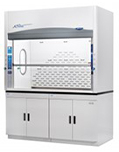In Part 1 of this guidance on ‘Developing a Basic Infection Control Policy (AICP)’ we discussed the most basic gear and equipment that must be noted in your policy. It was also stated that within this current medical pandemic crisis, an AICP should be written in less generalities and more specific to your respective laboratory and the potential hazards within. Instead of a general comment about wearing masks, face shields, or other standard Personal Protective Equipment (PPE), the notation must lean toward specific items such as what kind of masks. Again, this makes it specific for the types of potential respiratory hazards common to your environment. A good example is illustrated in the three images of facial masks shown below. Each have their own range and limitations of particulate parts per million that they are effective in filtering. To the far left we see the common basic cloth mask for general use in public places. In the center we see an FDA-approved surgical mask more appropriate for medical or laboratory professionals working in hospitals or clinics. To the far right we see the N95 Respirator. This item is specifically designed for medical professionals, health care workers, and other direct responders who are in direct contact with infectious patients or in environments that are high risk of airborne infection.

Beyond the specificity of PPE wear, an AICP will deal with the specificity of the environment. Air quality management is an absolute mandate in any environment where workers are exposed to chemicals, microbials, or particulate matter. With respect to the Histopathology lab, chemicals such as xylene, formalin, and alcohols should be monitored by air quality control specialists documenting the parts per million readings in the air environment as well as the individual exposure of each worker. This documentation should note the acceptable compliance standard range and list the current reading. This standard is typically monitored on an annual basis or whatever other testing regularity is approved by their regulatory board and/or Safety Officer.
Fume hoods and ventilation stations used in the laboratory should be monitored and maintained by recommended procedures noting annual airflow readings, filter changes (if applicable) and any other standards set by the commercial vendor. Proper use of each unit should be documented in your AICP including details such as the proper level the sash window should be kept, minimizing the number of items that can be kept inside the fume hood to avoid disruption of airflow, and other critical items. This documentation can be simplified by citing it from your equipment manual with appropriate section/page reference.

Another consideration that can be utilized in air quality management are specific air filtration units designed for non-workstation areas in the lab. Unlike fume hoods or ventilation stations, these air filtration system units are moveable, utilize a smaller footprint, and can be permanently or temporarily stationed in areas where airflow exchange is low. This AFS unit on the right minimizes fumes such as formalin, alcohol, and xylene, will clear in a range of 95 to 195 cubic feet per minute, and has a small footprint of 13” in diameter to 24” high. It was designed for both the bench top and floor, and to run continuously in the lab to maintain compliance standards at all times.

Having discussed some specifics about personal and environmental air management, the final consideration to discuss in developing/writing your AICP is format. For the Histopathology laboratory, Standard Operating Procedures (SOP) must be written for each specific discipline of your laboratory. In hospitals or reference labs these are written in a basic format from regulatory agencies such as the Clinical Laboratory Improvements Amendments (CLIA), the American Society of Clinical Pathologists (ASCP), or others. Much of this depends on who the regulatory agency would be for your specific industry. Pharmaceutical and/or research environments are often under different agencies and guidelines. A simple basic format for health care laboratories should include the following sections:
- Purpose – A statement outlining who the document is written for (your laboratory) and what is covered in the document
- General – A statement specific to the need for such a document and quality assurance it will provide. Example: ‘For the improvement, monitoring, and maintenance of air quality to ensure a safe working environment for employees.’
- Construct – A list and explanation of all the specific areas within the document
- Specificity in PPE (face masks and/or respirators)
- Equipment (Fume Hoods, ventilation stations, air filtration system, etc.) with documentation of proper use
- Quality Assurance – Method of routine maintenance checks on equipment performance including daily maintenance, documentation (Q.C. sheets with sign-off), data retention (logs).
- Safety – Statement mandating the use of PPE equipment, proper operation of specific equipment, containment/disposal of hazardous waste (masks), etc.
In lieu of the current health care crisis, and considering a highly contagious spreading virus (Covid-19), it is hoped that within this 2-part discussion the reader has gained some insight on the necessity of developing and validating an ongoing airborne infection control policy specific to your environment. These simple steps towards a new SOP will add to the efficacy of your safety manual and help ensure the safety of your health care professionals and their environment.
References:
- www.labconco.com
- www.labstore.com
- https://smartairfilters.com/en/blog/comparison-mask-standards-rating-effectiveness/

